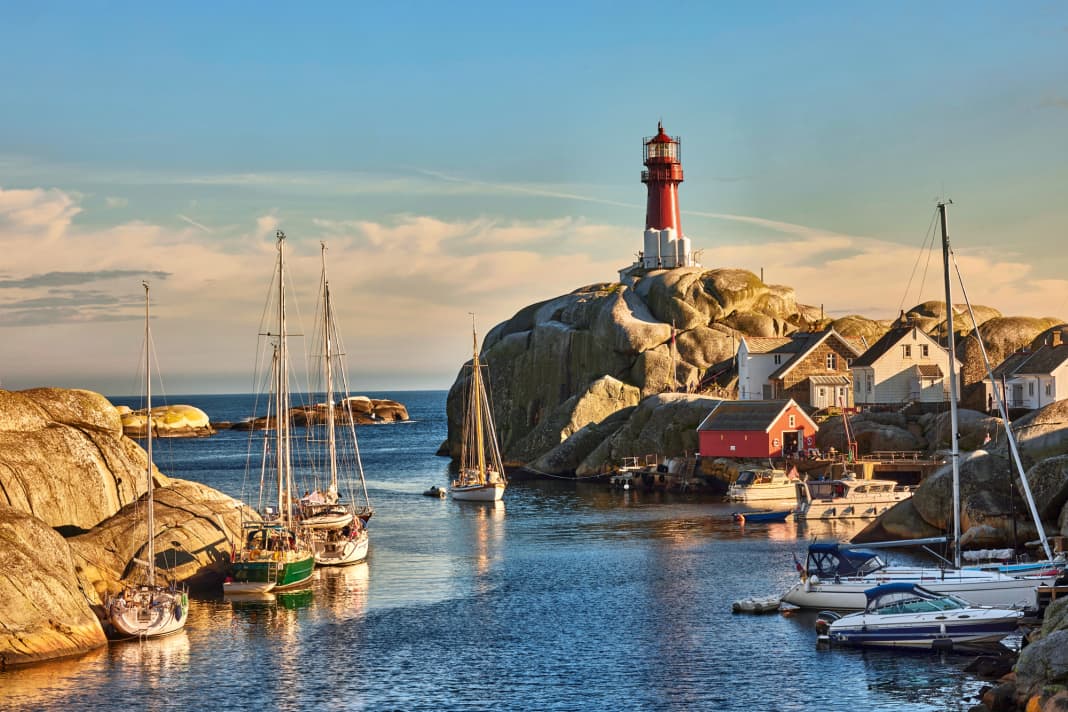





The small wooden houses on the archipelago can be recognised from afar. Bright white, shining and crouched against mighty rocks, they defy the storms and the force of the waves rolling in from the Skagerrak. The houses are built on granite and gneiss that has been polished smooth by the salty surf over thousands of years. A surface like shiny silk. Narrow fairways zigzag between the islands and countless half-submerged stones to the coast, marked only by rusty iron bars with top marks. Such scrap metal guarantees safe passage to the next harbour or the targeted anchorage.
Once you arrive safely behind one of the natural breakwaters formed by the rocks and skerries here, you are greeted by a soothing calm. The swell has gone and the wind has dropped a few Beaufort. This is characteristic of sailing along the coast of Sørlandet, as the Norwegians call the southern part of their country: It is only ever a few nautical miles from the open Skagerrak to the sheltered bays and islands. If heavy weather comes up, the next refuge is not far away, whether it's a bay, fjord or jetty.
Every anchorage a little adventure
This is also the experience of the family crew on the British "Summer Song", a Sadler 34. "The coast is really very varied. You can sail wonderfully here, and there's also plenty to do on land," enthuses skipper Sam Fortescue. "That's important for us, after all we have to look after our children. You can't just stubbornly do miles."
Before they set off for Norway, the parents thought a lot about how to keep the six and eight-year-old siblings occupied. But that was completely unnecessary. "Every anchorage is a new adventure for the children, every island needs to be explored. Climbing, swimming, romping around until they drop - we had to carry them back on board because they were so tired," says the father. Even when the crew was bogged down in Kristiansand harbour for three days due to a violent westerly storm, they never got bored: The world-famous zoo, exciting museums, good restaurants and cafés as well as a great swimming pool near the marina saved their holiday happiness. Hundreds of other crews have a similar experience.
A new adventure every day, every archipelago becomes a playground, every coastal town an open-air museum"
An ideal area for cruising
Other towns along the coastline, such as Arendal or Grimstad, also invite you to go ashore. The distances are manageable, and there is always a bay for a swim stop or an archipelago to moor overnight if a stopover is required. "Sailing in southern Norway can sometimes be a challenge. But if you make the most of the summer months and keep an eye on the wind and weather, you'll find an ideal cruising area here," says Gordon Fuglestad. The friendly Norwegian is the deputy harbour manager of Arendal. He not only looks after hundreds of guests and permanent residents, but is also responsible for the big ships and large cruise liners that sometimes moor here. Fuglestad's recommendation: "If it gets too busy in the narrow streets of the old town during the high season, it's best to sail the few nautical miles over to Club Island, moor at public jetties or anchor directly on the sandy beach north of Merdø Island."
In fact, the micro-region around Arendal alone offers enough variety for a trip lasting several days. As do the neighbouring stretches of coastline. Regardless of whether the crew is in the mood for relaxation or adventure. Only the long journey to the north of the Skagerrak prevents many German sailors from travelling to the area on their own keel. Even on a direct course, it is at least 300 nautical miles from Kiel to Kristiansand. If you want to call at harbours along the Danish or Swedish coast on the way, you will have to cover even more miles. You should allow one week for the outward journey and one week for the return journey. A lot of time, which usually limits the stay in the destination area to a few days, given the average of three weeks that most crews have available for the summer cruise.
"The ice age has smoothed the archipelago and in some places piled it up into truly enormous walls"
Norway also offers winter storage spaces
Not forgetting that the weather also has to play along. It shouldn't blow too hard, especially when crossing the Skagerrak, otherwise the holiday mood will soon be over. One way to save yourself stress and spend more time on the southern Norwegian coast is to change crews on the spot. This means that one crew sails the boat northwards and spends the rest of the time there. Then friends or acquaintances take over the yacht and also sail extensively, first locally and then back to Germany. Logistically, such a crew change is very straightforward. Southern Norway is easily accessible from all over Europe thanks to ferries via Denmark or by plane.
The harbour manager of Arendal has a completely different suggestion: "Boat owners from Germany can leave their yacht in the water with us in winter. We have a special offer for this from 1 September to 15 May. Boat companies from the region can also be easily commissioned to carry out maintenance and repair work," explains Gordon Fuglestad. In fact, there are several harbours between Oslo and Kristiansand that offer winter berths in the water or heated indoor berths on land for out-of-town yachts ( see below ).
Risør and the Trebåt Festival are a highlight
Whichever solution you choose, one destination should always be on the itinerary for southern Norway: Risør. This is one of those typical picturesque coastal towns that can only be found here: Small, old wooden houses are densely packed on a rock; they are inhabited and lovingly preserved, but not conserved as in an open-air museum. Roses grow on leaning house walls, fruit trees grow in small gardens, flowers bloom and herbs for the kitchen thrive. The warm summer air is filled with the scent of flowers and the cries of seagulls.
In some villages, the clocks seem to have stood still. You feel like you've travelled back in time"
Strolling along the cobbled streets of Risør, you feel like you've been transported back in time. This effect is heightened when hundreds of historic workboats and classic yachts moor in the harbour basin every year on the first weekend in August during the Trebåt Festival. A highlight not only for fans of maritime wooden treasures, but for all residents and visitors to Risør - and at the height of summer.
The south is the sunny side of Norway
Because there really is a summer worthy of the name in these latitudes. The coastal climate in southern Norway is relatively mild, which makes sailing from mid-June to the end of August comparatively pleasant. "The smiling south", as Norwegians affectionately refer to the region, is something like the sunny side of the country. In addition to rugged cliffs, there are always smooth, warmed-up rocky spots, often interspersed with small sandy beaches.
It goes without saying that the area is therefore also very popular with Norwegians themselves. In the high season, the harbours and bays can get crowded. Motorboats speed across the narrow fairways out to the islands and yachts begin to dance in their wake. The small fishing villages are also real tourist magnets during the holiday months. It can be difficult to get a seat in restaurants and bars without a reservation. This is all due to the short Scandinavian summer. It focusses people's festive mood on a short period of time, during which music festivals and spontaneous parties provide plenty of cheer, hustle and bustle and merriment in the towns and villages. Fortunately, you can escape this. There is always a quiet archipelago somewhere that invites you to stay.
Those who love fish or seafood will also get their money's worth along the coast. However, this is twofold: countless restaurants serve freshly caught fish from the sea, but in return they charge a lot more. Eating out in Norway is a costly affair, even simple dishes are expensive compared to German restaurant prices. Family skipper Sam Fortescue therefore advises asking neighbours or local sailors. "They know where you can get good food without running out of money afterwards." But there is another way: in Norway, everyone can help themselves from the sea. Simply hang a string and fishing hook in the stern sea. The local mackerel, for example, tastes better cooked over the embers of the campfire and served under the stars than in any restaurant.
Great mix of open sea and sheltered waters
On a rock in the sea south of Larvik, the Svenner fire shows sailors the way. The bright beam breaks through the twilight and travels across the sea. Below the beacon is a beautiful natural harbour. Behind a protective wall of rocks that the ice age has moulded into a huge breakwater, boats lie as if in Abraham's bosom. One of them is the sailing yacht "Fischkind", which is moored alongside the rock.
A real dream destination!"
Low-hanging fenders keep the wooden hull at a distance from the hard rock, the mooring lines are attached to iron hooks jammed in a crevice. "Climbing ashore is difficult. But it's incredibly beautiful here," says Carla Enchelmaier. Together with Jesper Pink, she has travelled here from Risør to explore the island and admire the sunset. The fireball between the rocks sinks into the sea, glowing red. The couple from Kappeln are travelling to southern Norway by boat for the first time. Their verdict after three weeks of summer cruising: "A breathtaking landscape and a great mix of open sea and sheltered archipelago waters - a real dream destination!"
Highlights and destinations in southern Norway
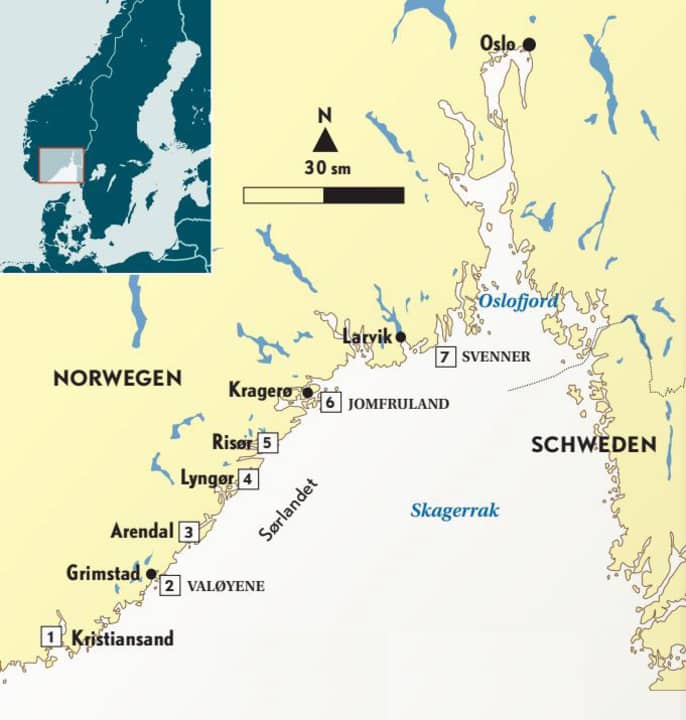
1. Kristiansand - culture and nature
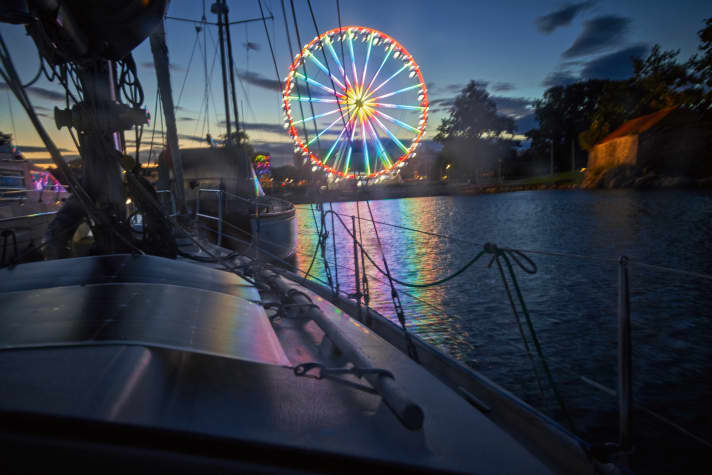
Worth seeing is the historic old town of Posebyen with its traditional wooden houses, neo-Gothic cathedral in the centre, Sørlandets Kunstmuseum, the animal park and many culinary delicacies from the sea on Fiskerbrygga Quay, where fishmongers sell their catch. Bystranda town beach is located on the south-east coast. The marina with good sanitary facilities and a washing machine is located right next to the 17th century Christiansholm circular fortress. There is a boat filling station in the private neighbouring harbour.
2 Valøyene - Robinson Crusoe in Norwegian
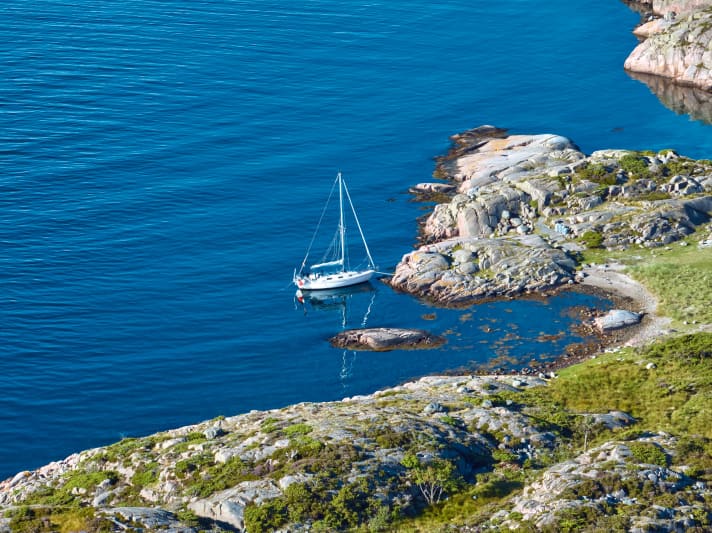
An archipelago southeast of Grimstad with many mooring possibilities on the rocks in front of the stern anchor. Anchoring with bow gear is also possible in some places. In unfavourable weather conditions there is swell from the Skagerrak, which finds its way between the islands. The nature reserve has beautiful hiking trails and bathing areas. There are also barbecue areas and dry toilets.
3 Arendal - from tranquil to lively
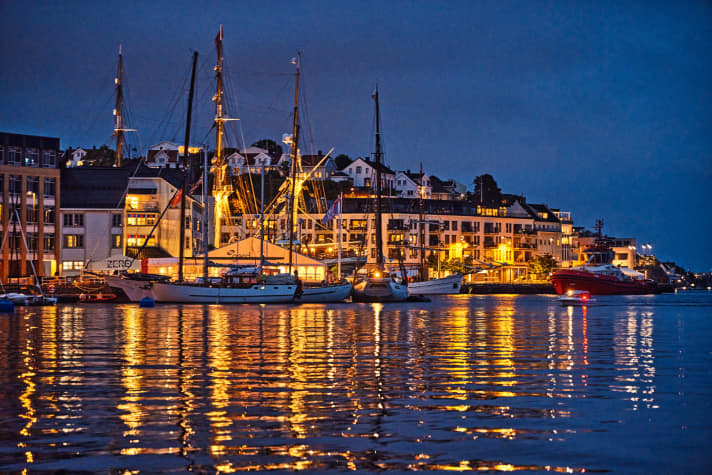
There are restaurants, a shopping centre and the finest boutiques here. Gjestehavn is centrally located on a jetty with a swimming pool and bar. Petrol station in the harbour. Larger yachts moor alongside the quay in the old harbour of Pollen. Arendals Seilforening harbour is quieter. On the small skerry Søndre Brattholmene there are wooden jetties with a few guest berths and the most necessary service facilities. The island of Merdø, a few miles to the south, is even more idyllic. Day visitors come here to swim and eat at the "Merdø Kro". Anchor directly in front of the beach or go into a box on one of the two jetties or moor alongside.
4. lyngør - art on the island
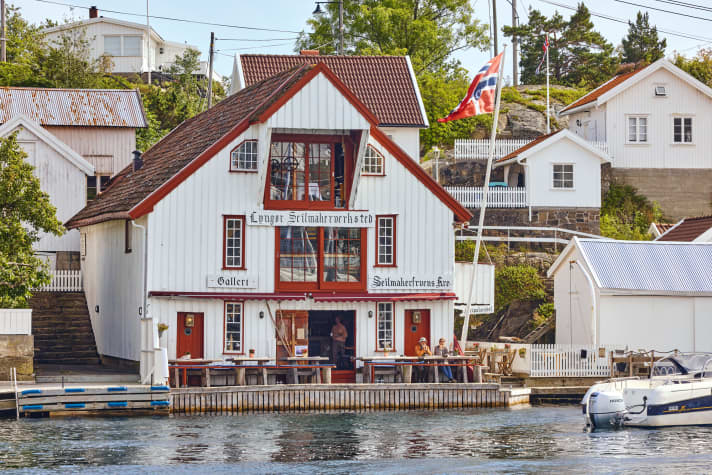
The skerry off the picturesque coastal town of Kragerø was once home to local fishermen. Pilots also had a station here. Today, the archipelago is a popular address for holiday homes and leisure boats. You should definitely pay a visit to the old sailing workshop. It now houses a photo gallery and a restaurant. You can moor right outside the door or at a guest jetty between the skerries.
5th Risør - sailing and partying
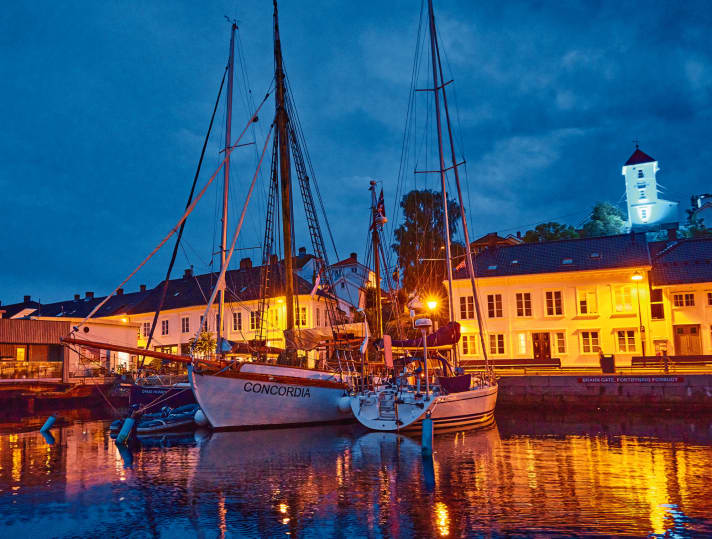
The white wooden houses on the hills are famous, the boat-building tradition is still omnipresent today and the legendary hospitality can always be felt. This is particularly evident at the Trebåt Festival, which takes place every year on the first weekend in August and attracts classics from all over the Baltic region. The town's old façades conceal many good restaurants, bars and craft shops. If possible, take your own boat to the inner part of the old harbour, where it is most sheltered. On bright summer nights, however, you can expect the hustle and bustle to continue until the early hours.
6. jomfruland - breakwater and bird island
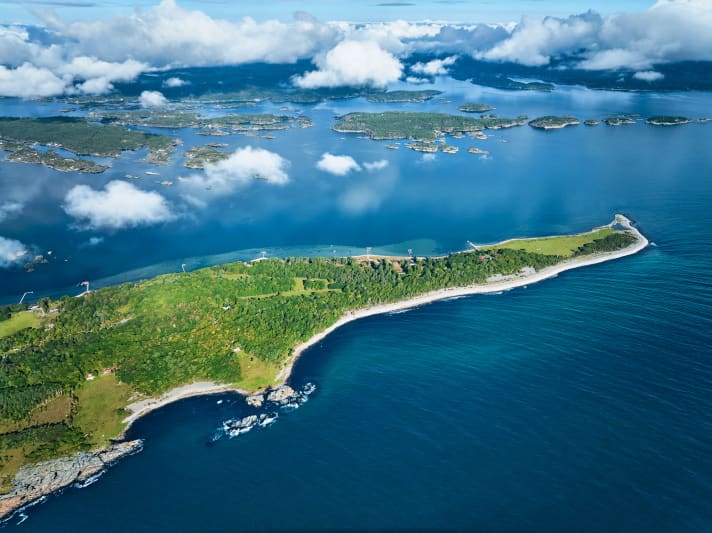
The "Island of the Virgin" is an almost eight-kilometre-long moraine of boulders that protects the archipelago behind it from wind and waves. Jomfruland is said to be home to more than 300 bird species. The floating dock for around 40 yachts fills up quickly in summer, and Norwegians love the flat island. So arrive early. The best way to explore is by bike; there is a hire shop right by the lighthouse.
7th Svenner - Abraham's bosom in the Skagerrak
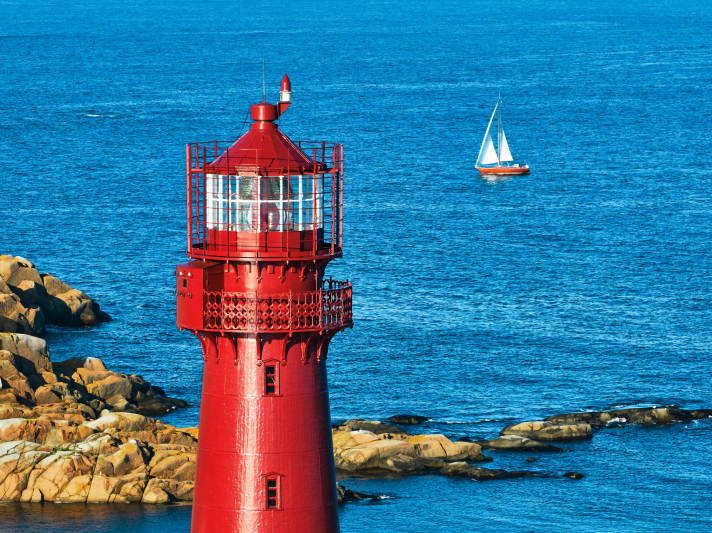
The approach via Storløpet requires some concentration from the navigator and helmsman, but once you have found your way into the natural harbour, you won't want to leave. Moor alongside the rock in water up to three metres deep or in front of the stern anchor on a small jetty. Anchoring in strong winds from south to west is not recommended. Then it is better to anchor in the northern arch, the northern bay with a sandy beach.
Tips for the trip
The precinct
Southern Norway is flanked by the Skagerrak, a sometimes rough area. But along the coast, skerries, bays and fjords reduce the force of the wind and waves. Watch out for jet effects. The fairways between the islands are usually well marked, and the nautical charts are so accurate that you can sail outside the fairway with the necessary care. The water depths usually fall away quickly from the skerries and steep coasts. There are only shallow areas in river estuaries, between closely spaced islands and off shallow shore areas. The tidal current can be up to three knots. Strong south-westerly to westerly winds can sometimes cause chaotic waves for long periods, which makes it particularly difficult to cross.
Harbours & Marinas
For Norwegians, the boat has always been a normal means of transport, and there are correspondingly many moorings, jetties or facilities for mooring to the rocks along the coast and in the archipelago. The harbour guides list over 300 mooring possibilities for yachts along the coastal section described. The marinas are mostly modern, but quite expensive and not particularly large. In the short period of high summer, some places can therefore quickly become full. However, there is usually always somewhere to moor your boat, at least for a limited time, so that you can run errands. The boat refuelling stations in the harbours are open around the clock in many places.
Wind & Weather
The prevailing wind direction is west or south-west, rarely east. Near the coast, the wind almost always blows parallel to the land. This means you either have to cross or sail flat out in front of the sheet. The air temperature is 20 degrees Celsius from June to August, with an average water temperature of 18 degrees Celsius.
Sea charts
- NV Carts Pilot 1,Planning map Baltic Sea - Kristiansand to Helsinki
- NV Atlas NO2 - Oslofjord Sør - Svenska Grensen til Kragerø
- NV Atlas Norway NO3 - Sørlandet East - Kragerø to Kristiansand
Harbour & area guide
- Havneguiden 1+2 Svinesund to Langesund and Langesund to Lindesnes, Skagerrak-Verlag (in Norwegian and English, online version integrated)
- Norway area guide (RCC) by Judy Lomax, the standard work for the entire Norwegian coastal areas from Oslo to the North Cape including Svalbard.
Option: Winter storage in Norway or Sweden
The relatively long journey leaves sailors little time on site. It is therefore worth considering winterising your yacht in the north. A water berth in winter in southern Norway or western Sweden for a 36-foot yacht costs the equivalent of around 80 to 150 euros per month, a heated indoor berth 250 to 550 euros. Below is a selection of winter storage facilities:
- Arendal:Water berth in the city marina from 1.9. to 31.5. booking: APP.HAVNEWEB.NO
- Sandefjord:Sufficient indoor and outdoor pitches available. Storage possible from 15 August to 15 June, very good service facilities. Booking: FRAMNES-MARITIME.NO
- Frederikstad:Some winter storage sites in the water and on land. Info: Frode Samuelsen, FROSAM@FREDRIKSTAD.KOMMUNE.NO
- Stenungsund/Western Sweden: Wintering possible in the protected municipal harbour on land or in the water; service provided by private companies. Info: STENUNGSUND.SE
Customs regulations
A foreign yacht may remain in Norwegian territory for up to six weeks without the owners being on board. An "interruption of voyage" must be declared to customs for a period of up to two years. Info: WWW.TOLL.NO/EN/GOODS/BOAT/STORING-A-FOREIGN-RECREATIONAL-BOAT

